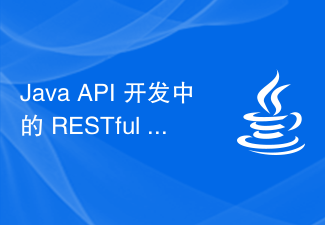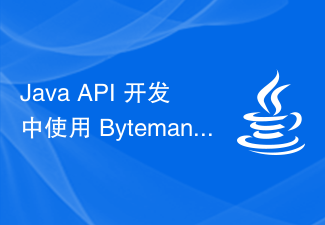In the context of the current development of the Internet, front-end technology has undergone earth-shaking changes. The front-end is no longer the "artist" of the past, but requires a certain level of programming ability and understanding to be competent. Asynchronous processing is an important part of front-end development. It can realize parallel processing of tasks such as network requests, thereby providing users with a better experience. This article will introduce how to use RxJS for front-end asynchronous processing in Java API development.
1. What is RxJS
RxJS is a library based on the ReactiveX programming paradigm. ReactiveX is a cross-language programming paradigm mainly used for asynchronous programming and event-driven programming. RxJS is an implementation of ReactiveX in JavaScript that handles asynchronous events through Observables and Operators. The main features of RxJS include the following aspects:
- Responsive programming paradigm: RxJS provides basic concepts such as Observables, Operators and Subscriptions, which can more easily implement the reactive programming paradigm.
- Event-driven: RxJS can easily handle event sequences to achieve asynchronous programming.
- Can cooperate with other frameworks: RxJS can be used not only for front-end development, but also for back-end development and mobile application development and other fields.
- Convenient processing of complex data streams: RxJS provides powerful Operators that can easily process and convert data streams.
2. How to use RxJS in Java API
For Java API developers, using RxJS for front-end asynchronous processing may seem a bit unfamiliar. However, as long as you follow the following steps step by step, you will be able to master the use of RxJS:
- Install RxJS: In order to use RxJS, you need to install RxJS in the project. You can install it using npm or reference external resources through a CDN.
- Introduce RxJS: In files that need to use RxJS, you can introduce RxJS through the following code:
import { Observable } from 'rxjs';
- Create Observables: Observables are the core concept in RxJS and are used to handle asynchronous events. Observables can be created in the following ways:
const observable = new Observable((subscriber) => {
subscriber.next('hello');
setTimeout(() = > {
subscriber.next('world');
subscriber.complete();
},5000);
})
In this example, the observable is An Observable is created using new Observable((subscriber)=>{}). In subscriber, we can define methods such as next, error and complete to handle asynchronous events.
- Use Operators to process Observables: Operators in RxJS can be used to process and transform Observables. For example, map(), filter() and switchMap() are commonly used Operators. For example, we can use map() to perform mapping operations on Observables, making the processing of asynchronous events more convenient:
observable.pipe(map((value) => {
return value .toUpperCase();
}));
In this example, we use the pipe() method to apply the map() Operator to the observable, thus realizing the mapping operation of asynchronous events.
- Subscriptions: When using RxJS for asynchronous processing, be sure to use Subscription to control the life cycle of Observables. For example:
const subscription = observable.subscribe((value) => {
console.log(value);
});
In this example , we use subscribe() to subscribe to the Observable, and the subscription returns a Subscription object, which can be used to control the life cycle of the Observable.
3. Use RxJS to handle front-end asynchronous events
In front-end development, asynchronous events are very common, such as network requests, timers, etc. Using RxJS makes it easier to handle these asynchronous events, improving efficiency and user experience. Here is a simple example:
import { ajax } from 'rxjs/ajax';
import { switchMap } from 'rxjs/operators';
import { fromEvent } from 'rxjs';
const button = document.getElementById('button');
const output = document.getElementById('output');
fromEvent(button, 'click')
.pipe(
switchMap(() => ajax('https://jsonplaceholder.typicode.com/todos/1'))
)
.subscribe((res) => {
output.innerHTML = res.response.title;
});
In this example, we use the fromEvent() method to handle a click event. Then use switchMap() Operator to implement asynchronous network requests. Finally, use subscribe() to subscribe to the returned results of the event and display the results on the page.
4. Summary
Using RxJS can effectively improve the processing efficiency of front-end asynchronous events, thereby providing users with a better experience. This article introduces how to use RxJS to handle front-end asynchronous events in Java API development, mainly including installation, introducing RxJS, creating Observables, using Operators to process Observables and controlling the life cycle of Observables. I hope this article can help Java API developers better apply RxJS to handle front-end asynchronous events.
The above is the detailed content of Using RxJS for front-end asynchronous processing in Java API development. For more information, please follow other related articles on the PHP Chinese website!
 Java API 开发中使用 ZooKeeper 进行分布式锁处理Jun 17, 2023 pm 10:36 PM
Java API 开发中使用 ZooKeeper 进行分布式锁处理Jun 17, 2023 pm 10:36 PM随着现代应用程序的不断发展和对高可用性和并发性的需求日益增长,分布式系统架构变得越来越普遍。在分布式系统中,多个进程或节点同时运行并共同完成任务,进程之间的同步变得尤为重要。由于分布式环境下许多节点可以同时访问共享资源,因此,在分布式系统中,如何处理并发和同步问题成为了一项重要的任务。在此方面,ZooKeeper已经成为了一个非常流行的解决方案。ZooKee
 如何调试 PHP 函数中异步处理问题?Apr 17, 2024 pm 12:30 PM
如何调试 PHP 函数中异步处理问题?Apr 17, 2024 pm 12:30 PM如何调试PHP函数中的异步处理问题?使用Xdebug设置断点并检查堆栈跟踪,寻找与协程或ReactPHP组件相关的调用。启用ReactPHP调试信息,查看额外的日志信息,包括异常和堆栈跟踪。
 Python web开发中的异步处理技巧Jun 17, 2023 am 08:42 AM
Python web开发中的异步处理技巧Jun 17, 2023 am 08:42 AMPython是一门非常流行的编程语言,在Web开发领域中也有广泛应用。随着技术的发展,越来越多的人开始使用异步方式来提高网站性能。在这篇文章中,我们将探讨Pythonweb开发中的异步处理技巧。一、什么是异步?传统的Web服务器使用同步方式处理请求。当一个客户端发起一个请求时,服务器必须等待该请求完成处理后,才能继续处理下一个请求。在高流量的网站上,这种同
 Java API 开发中的 RESTful 接口设计Jun 18, 2023 am 08:31 AM
Java API 开发中的 RESTful 接口设计Jun 18, 2023 am 08:31 AM随着互联网技术的发展,RESTful风格的API设计成为了最为流行的一种设计方式。而Java作为一种主要的编程语言,也越来越多地在RESTful接口的开发中扮演着重要的角色。在JavaAPI开发中,如何设计出优秀的RESTful接口,成为了一个需要我们深入思考的问题。RESTful接口的基本原则首先,我们需要了解RESTful接口的基本原则。REST即Re
 PHP中使用Redis实现异步处理May 16, 2023 pm 05:00 PM
PHP中使用Redis实现异步处理May 16, 2023 pm 05:00 PM随着互联网的发展,Web应用程序的性能和效率成为了关注的焦点。而PHP是一种常用的Web开发语言,Redis则是一款流行的内存数据库,如何将二者结合起来提高Web应用程序的性能和效率就成为了一个重要的问题。Redis是一个非关系型内存数据库,具有高性能、高可扩展性和高可靠性等优点。PHP可以使用Redis来实现异步处理,从而提高Web应用程序的响应速度和并发
 golang函数错误处理中的异步处理May 03, 2024 pm 03:06 PM
golang函数错误处理中的异步处理May 03, 2024 pm 03:06 PM在Go函数中,异步错误处理通过使用error通道,异步地从goroutine传递错误。具体步骤如下:创建一个error通道。启动一个goroutine来执行操作并异步发送错误。使用select语句从通道接收错误。异步处理错误,例如打印或记录错误消息。该方法可以提高并发代码的性能和可伸缩性,因为错误处理不会阻塞调用线程,并且可以取消执行。
 Java API 开发中使用 Hutool 进行工具类处理Jun 17, 2023 pm 10:53 PM
Java API 开发中使用 Hutool 进行工具类处理Jun 17, 2023 pm 10:53 PMJava开发人员在进行API开发时,往往需要处理各种工具类,这些工具类可以节省开发时间并且提高代码的可复用性。Hutool是一个Java工具类库,提供了丰富的工具类和常用的算法,能够提高API开发的效率。Hutool支持Java8及以上版本,可以方便地用于各种场景,例如字符串处理、日期时间处理、加密解密、文件操作等等,以下就是一些常用的功能。字符串处理Hut
 Java API 开发中使用 Byteman 进行动态代码注入Jun 18, 2023 am 08:03 AM
Java API 开发中使用 Byteman 进行动态代码注入Jun 18, 2023 am 08:03 AMJavaAPI开发中使用Byteman进行动态代码注入在日常的JavaAPI开发中,经常会遇到一些需要进行动态代码注入的场景。动态代码注入可以用于调试、测试和性能分析等方面。在Java开发中,Byteman是一个常用的工具,它提供了一种简单且灵活的方式来进行动态字节码注入。Byteman是一个开源的Java工具,它可以在Java


Hot AI Tools

Undresser.AI Undress
AI-powered app for creating realistic nude photos

AI Clothes Remover
Online AI tool for removing clothes from photos.

Undress AI Tool
Undress images for free

Clothoff.io
AI clothes remover

AI Hentai Generator
Generate AI Hentai for free.

Hot Article

Hot Tools

Atom editor mac version download
The most popular open source editor

Dreamweaver Mac version
Visual web development tools

VSCode Windows 64-bit Download
A free and powerful IDE editor launched by Microsoft

SAP NetWeaver Server Adapter for Eclipse
Integrate Eclipse with SAP NetWeaver application server.

EditPlus Chinese cracked version
Small size, syntax highlighting, does not support code prompt function





